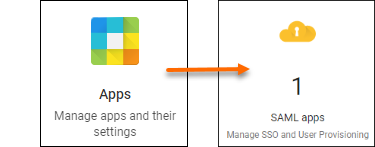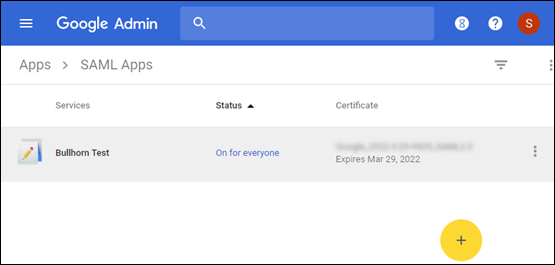SSO Setup for Google Suite (GSuite)
SAML Single Sign-On (SSO) enables users to use one set of login credentials to access multiple applications, such as Bullhorn and Email. This article will outline the steps for configuring SSO for Google Suite (GSuite). If you're looking to configure a different SSO provider, navigate to SSO.
Steps
- Log in to Google Admin.
- Choose Add a service/App to your domain or click the plus (+) icon in the bottom corner.

- Select Apps and then SAML apps.

- Select Setup my own custom SAML App. The Google IDP Information window opens with the Single Sign-On URL and the Entity ID URL fields populated.

- Collect the service provider setup information.
- Provide this information to Bullhorn Support by submitting a ticket. The ticket must include one of the two following pieces of information:
- Select Next.
- In the Basic Application Information window add an application name and description, then select Next.
- In the Service Provider Details window, enter:
- Entity ID: http://www.bullhornstaffing.com
For S Release:
- ACS URL: https://www.bullhornstaffing.com/BullhornStaffing/SAML/login_srel.cfm
- Start URL: https://www.bullhornstaffing.com/BullhornStaffing/SAML/login_srel.cfm
- ACS URL: https://universal.bullhornstaffing.com/universal-login/login
- Start URL: https://universal.bullhornstaffing.com/universal-login/login
- Leave Signed Responseunchecked.
- Select Next.
- Select Finish.

Turn on SSO for Your New SAML App
- Go to Apps, then click SAML apps.

- Select your new SAML app.

- At the top of the gray box, click the three vertical dots for More Settings.
- Choose one of the following options:
- Ensure that your user account email IDs match those in your G Suite domain.
- After Bullhorn Support finishes your configuration setup (with the details you provided), create Bullhorn user profiles to enable SSO. Make sure to populate their ATS Name ID.
SSO User Enablement
After setting up your specific provider, SSO must be enabled for each user. You can grant user access individually or in bulk with assistance from Bullhorn Support.
You must be a Bullhorn Administrator to complete these steps.
Single User
Follow these steps to grant user access individually.
- Navigate to Menu > Admin > Users.
- Click the Pencil icon to the left of the user to enable.
- In the Account Information section, from the Identity Provider drop-down, select your new client provider.

- In the new ATS Name ID field that appears, enter the Name ID of the user. Usually, this is their email address.
- If the user should also have access to SSO via their mobile device, select the Separate mobile Identity Provider check box.

- Click Save.
En Masse
Bullhorn can enable multiple users en masse by using a CSV file provided by you.
- Navigate to Menu > Admin > Users.
- Click Select an Action > Generate User List.
- Change the Format to Excel 2000, then click Generate Report.
- Open the downloaded file and edit it to only include users you want enabled.
- Remove all API users or any that shouldn't have SSO access.
- Rename the Login Name column to User.
- Delete all other columns.
- Click File > Save As.
- Select This PC as the location and change the file type to CSV (Comma delimited) (*.csv).
- Click Save.
- Send this file to Bullhorn Support.
Was this helpful?



